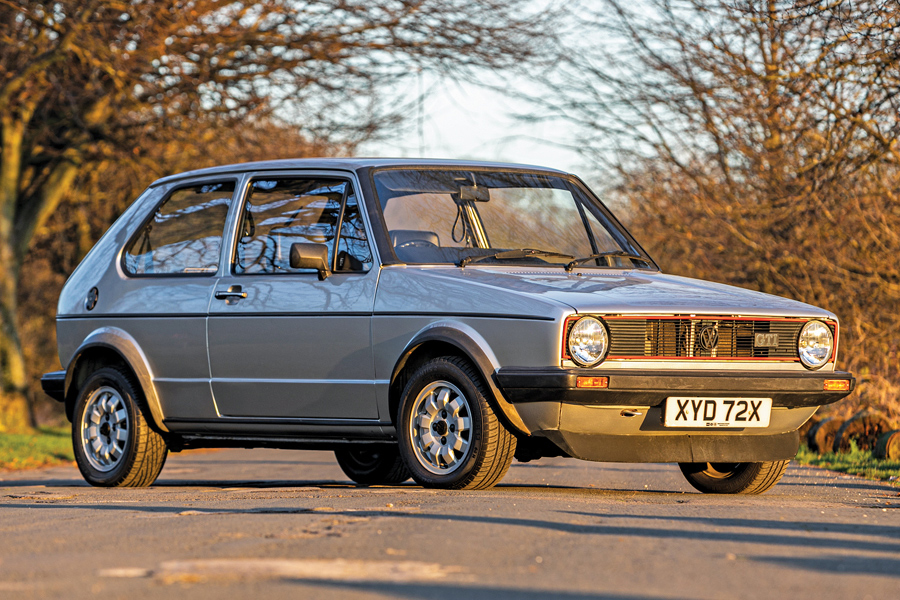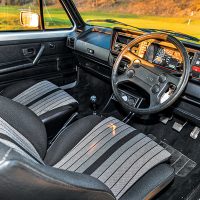SCM Analysis
Detailing
| Vehicle: | 1981 Volkswagen Golf GTI Mk1 |
| Years Produced: | 1975–84 (1983–84 for the U.S. market) |
| Number Produced: | 462,000 (about 30,000 U.S. cars) |
| Original List Price: | $8,350 |
| SCM Valuation: | $22,000 |
| Chassis Number Location: | On left-hand side of dash near windshield |
| Engine Number Location: | On the block under the spark plugs for cylinders three and four |
| Club Info: | Volkswagen Club of America |
| Website: | http://vwclub.org |
| Alternatives: | 1978–83 Porsche 911 SC, 1981–85 Toyota Celica Supra, 1984–88 Pontiac Fiero 2M4 |
| Investment Grade: | B |
This car, Lot 403, sold for $23,281, including buyer’s premium, at Silverstone Auctions’ Race Retro auction at Stoneleigh Park, U.K., on February 22, 2020.
With the back-end lines of an abbreviated Saab 99 Turbo and a blunted nose reminiscent of Soviet-bloc brutalist architecture, the first-generation Volkswagen Golf was the perfect embodiment of its time and place — Germany in 1975.
The Mark 1 GTI didn’t invent the sporty and family-friendly car. There had been hot hatches before the GTI, although we didn’t know to call them that yet. However, the GTI was so successful at combining an enlivening driving experience with calculated utility that it quickly defined the burgeoning hot-hatch category and became its poster child.
You surely know the GTI’s genesis story. Keen to replace the aging Beetle, VW designers crafted the front-engine Golf. They gave it a refined interior, an accessible price point and a rear cargo area that would make even some full-size sedans envious.
One hot hatch
VW designers then took that winning formula and tarted it up. They fitted the Audi 1,588-cc, 4-cylinder engine under the Golf’s flat-nose hood. They added some flat-black, red-accented trim and a stiffer suspension.
Et voilà, the GTI was born.
In European markets, the GTI’s 4-banger churned out 110 horsepower. By the time the GTI (under the Rabbit nameplate) made it to American shores in 1983, it boasted a federalized 1,780-cc 4-banger that whipped out a modest 90 horsepower at 5,500 rpm and 105 foot-pounds of torque at 3,250 rpm. Even with just 90 ponies pushing to the pavement, the 2,200-pound U.S.-market Rabbit GTI could charge 0–60 mph in 10.6 seconds.
Remember, the ’80s were a weird time for performance cars. For reference, the GTI was faster than the Audi Coupe and BMW 320i — and just 0.6 seconds slower to 60 than the Saab 900 Turbo that year.
For its time, the Mk1 GTI was actually impressively quick.
You can unfurrow your brow now. No, I am not going to focus on 0–60 mph times when discussing the GTI. Of course, straight-line runs were not the GTI’s reason for existing. Aside from efficiently hauling stuff, the GTI was designed for cornering.
The GTI’s front spring rate was 22% stiffer than the 1982 Rabbit’s. The rear springs were changed from progressive to linear and stiffened by 29%. Further rigidifying the rear, engineers at VW America upped the valving of the Rabbit GTI’s rear shocks, making it stiffer than even the European-market Golf GTI.
The results were staggering. In 1982, the Rabbit GTI was clocked at 0.797g in lateral acceleration. And it could do a 700-foot slalom at 61.3 miles per hour. To put that in perspective, a 1980 Porsche 911 SC pulled 0.789g on the skid pad and 59.7 miles per hour in the slalom.
To say the GTI was impressively quick was an understatement. Its performance bona fides were downright monumental.
Imagine a 2020 GTI outperforming a modern 911 today. Lives would be upended. Anarchy would break out in Stuttgart. Porsche engineers and their families would be too embarrassed to be seen in public.
But in the early ’80s, that’s exactly what the GTI had accomplished. From the lens of 2020, it’s hard to even fathom.
From fame to shame
The GTI started off incredibly strong. Once on the tip of the tongue of every sports-car enthusiast, by the late 1990s, the Mk1 GTI was mostly forgotten.
There were a few hangers-on, though — mostly enthusiasts of 1970s VWs. These people are largely insufferable.
On one end of the scale, there were the penny-pinching performance weirdos who bought a Mk1 GTI secondhand in 1985 and never let go — and never shut up about their cars. They were as vocal about their GTI’s performance bona fides as they were averse to ever performing regular maintenance on the cars.
On the other end of the Mk1 GTI enthusiast scale were the flat-brim-hat wearers. These guys lowered the GTIs by cutting coils, haphazardly futzed with the engines, let their Swisher Sweets cigars burn holes in the upholstery and bolted up Chinese-made pseudo-performance parts they purchased on eBay.
The result was a whole heap of Mk1 GTIs that were either never maintained or overly mistreated and questionably modified. Anyone with sense steered clear of these unfortunate examples during the past 20 years.
Pristine cars still exist
What’s left running around today are the rare Mk1 GTIs that were spared the indignity of living with a feckless, reckless VW enthusiast.
Our unmolested 1981 VW GTI 1600 recently fetched $23,281 at the Silverstone Race Retro auction. This right-hand-drive English-market example had only spun 42,156 miles since new. It was so well kept that the cardboard rear luggage tray was intact. Aftermarket speakers were never fitted either.
This car was in remarkable nick.
What’s great about Mk1 GTIs is that they’re just as fun today as they were when new. I had the opportunity to drive an original U.S.-spec Mk1 GTI from the VW America collection a few years back. I was blown away by its charms.
It wasn’t quick by modern standards. That didn’t matter, though.
It was plucky and light on its feet. It was incredibly nimble; it changed direction like a kitten chasing a spider. It is one of the few cars that has ever made me giggle uncontrollably from the first corner.
Now that Porsches are worth their weight in gold, and ’80s Bimmers are following suit, the Mk1 GTI is now a prime candidate for a budget-minded collector seeking to put a bit of understated Teutonic charm in their garage. Good examples aren’t really that easy to find, I’m afraid. But, when you do, they’re not terribly expensive to buy or maintain — yet.
I anticipate the market for non-thrashed Mk1 GTIs will skyrocket in the coming years. For my money, this one was well bought. ♦




